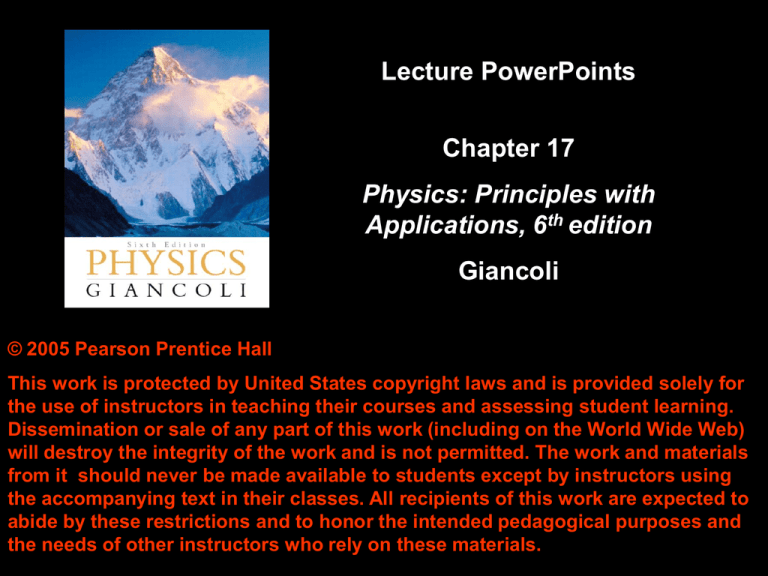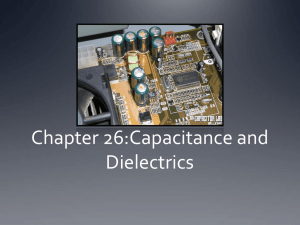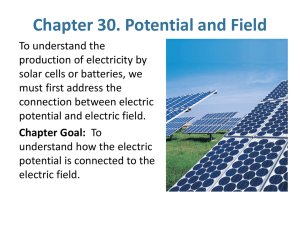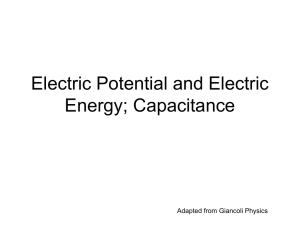
Lecture PowerPoints
Chapter 17
Physics: Principles with
Applications, 6th edition
Giancoli
© 2005 Pearson Prentice Hall
This work is protected by United States copyright laws and is provided solely for
the use of instructors in teaching their courses and assessing student learning.
Dissemination or sale of any part of this work (including on the World Wide Web)
will destroy the integrity of the work and is not permitted. The work and materials
from it should never be made available to students except by instructors using
the accompanying text in their classes. All recipients of this work are expected to
abide by these restrictions and to honor the intended pedagogical purposes and
the needs of other instructors who rely on these materials.
Chapter 17
Electric Potential
17.1 Electrostatic Potential Energy and
Potential Difference
Change in electric potential
energy is negative of work
done by electric force:
(17-1)
(What is qE?)
17.1 Electrostatic Potential Energy and
Potential Difference
Electric potential (or Potential Difference) is
defined as potential energy per unit charge:
Electric potential is not Potential Energy.
Unit of electric potential: the volt (V).
1 V = 1 J/C.
17.1 Electrostatic Potential Energy and
Potential Difference
Only changes in potential can be measured,
allowing free assignment of V = 0.
ΔPE (or UE) = qV (on formula sheet)
17.1 Electrostatic Potential Energy and
Potential Difference
Analogy between gravitational and electrical
potential energy:
Both rocks have the same
gravitational potential, but
the bigger rock has more PE.
Both charges have the
same electric potential,
but the 2Q charge has
more PE.
Table 17-1
Some Typical Potential Differences (Voltages)
Example 17-1
What is the change in
potential energy of the
electron in going from a
to b?
What is the speed of the
electron as a result of
this acceleration?
Repeat both calculations
for a proton.
p. 491 #56
17.2 Relation between Electric Potential
and Electric Field
Work is charge multiplied by potential:
Work is also force multiplied by
distance:
17.2 Relation between Electric Potential
and Electric Field
Solving for the field,
The minus sign tells us the Electric field direction.
It points in the direction of decreasing potential V.
17.3 Equipotential Lines
An equipotential
(represented by the green
dashed lines) is a line or
surface over which the
potential is constant.
Electric field lines are
perpendicular to
equipotentials.
The surface of a conductor is
an equipotential.
17.3 Equipotential Lines
17.4 The Electron Volt, a Unit of Energy
A Joule is too large when dealing with
electrons or atoms, so electron volts are
used. One electron volt (eV) is the energy
gained by an electron moving through a
potential difference of one volt.
17.5 Electric Potential Due to Point
Charges
The electric potential due to a point charge
can be derived using calculus.
(on formula sheet)
17.5 Electric Potential Due to Point
Charges
These plots show the
potential due to (a)
positive and (b) negative
charge.
What minimum work is required by an external
force to bring a charge q = 3.00 μC from a great
distance away (r = infinity) to a point 0.500 m
from a charge Q = 20.0 μC ?
17.5 Electric Potential Due to Point
Charges
Using potentials instead of fields can make
solving problems much easier – potential is a
scalar quantity, whereas the field is a vector.
Calculate the electric potential at points A and B.
(Since potential is scalar, don’t worry about angles)
Which pair of charges has a positive
potential energy?
Which pair of charges has the most
negative potential energy?
Which pair of charges requires the
most work to separate the charges to
infinity?
The potential energy equals the work
required to bring the two charges
near each other, starting at a great
distance.
17.7 Capacitance
A capacitor consists of two conductors
that are close but not touching. A
capacitor has the ability to store electric
charge.
17.7 Capacitance
Parallel-plate capacitor connected to battery. (b)
is a circuit diagram.
17.7 Capacitance
When a capacitor is connected to a battery, the
charge on its plates is proportional to the
voltage:
(on formula sheet)
The quantity C is called the capacitance.
Unit of capacitance: the farad (F)
1 F = 1 C/V
17.7 Capacitance
The capacitance does not depend on the
voltage; it is a function of the geometry and
materials of the capacitor.
For a parallel-plate capacitor:
(on formula sheet)
17.8 Dielectrics
A dielectric is an insulator, and is
characterized by a dielectric constant K.
Capacitance of a parallel-plate capacitor filled
with dielectric:
17.8 Dielectrics
Dielectric strength is the
maximum field a
dielectric can experience
without breaking down.
17.8 Dielectrics
The molecules in a dielectric tend to become oriented
in a way that reduces the external field.
The dielectric blocks some of the electric field lines, so
the voltage decreases. Since Q=CV, if V decreases, C
increases. Q must stay constant because the capacitor is
not connected to a voltage source.
17.8 Dielectrics
This means that the electric field within the
dielectric is less than it would be in air,
allowing more charge to be stored for the
same potential.
An air filled capacitor consisting of two
parallel plates separated by a distance d is
connected to a battery of voltage V and
acquires a charge Q. While it is still
connected to the battery, a slab of
dielectric material with K=3 is inserted
between the plates of the capacitor. Will Q
increase, decrease, or stay the same?
Suppose the air filled capacitor in the
previous question is charged and then
disconnected from the battery. Next a
dielectric is inserted between the plates.
Will Q, C, or V change?
p. 491 # 64
Key of a computer keyboard
17.9 Storage of Electric Energy
A charged capacitor stores electric energy;
the energy stored is equal to the work done
to charge the capacitor.
(Using Q = CV and substituting)
(Uc = ½ QV is on formula sheet)
A camera flash unit stores energy in a
150 μF capacitor at 200 V. How much
electric energy can be stored?
A parallel plate capacitor carries charge Q
and is then disconnected from a battery.
The two plates are initially separated by a
distance d. Suppose the plates are pulled
apart until the separation is 2d. How has
the energy stored in this capacitor
changed?
17.10 Cathode Ray Tube: TV and
Computer Monitors, Oscilloscope
A cathode ray tube
contains a wire cathode
that, when heated, emits
electrons. A voltage
source causes the
electrons to travel to the
anode.
17.10 Cathode Ray Tube: TV and
Computer Monitors, Oscilloscope
The electrons can be steered using electric or
magnetic fields.
17.10 Cathode Ray Tube: TV and
Computer Monitors, Oscilloscope
Televisions and computer monitors (except for LCD
and plasma models) have a large
cathode ray tube as
their display.
Variations in the field
steer the electrons on
their way to the
screen. For standard
TV, 525 lines are
drawn in 1/30 s. High
definition is more than
double this number.
17.10 Cathode Ray Tube: TV and
Computer Monitors, Oscilloscope
An oscilloscope displays en electrical signal on
a screen, using it to deflect the beam vertically
while it sweeps horizontally.








